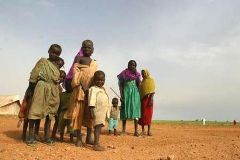War in Darfur: the who’s and why’s of the world’s worst humanitarian crisis
By ELLEN KNICKMEYER, Associated Press Writer
KHARTOUM, Sudan, Oct 21, 2004 (AP) — War in western Sudan’s Darfur province often is called a clash between Arab herders and African farmers, but it’s not that simple: Combatants on both sides are largely black Africans, for example, and the divide between them is more about culture than skin tone.
 Traditional tensions between the two groups have escalated to a level of bloodletting that the United States calls government-backed genocide, and the United Nations calls the world’s worst humanitarian crisis.
Traditional tensions between the two groups have escalated to a level of bloodletting that the United States calls government-backed genocide, and the United Nations calls the world’s worst humanitarian crisis.
Here are some common questions about the Darfur conflict:
Q. What is Darfur?
A. Darfur means “Homeland of the Fur,” the name of one of the remote region’s sedentary, non-Arab tribes. An independent Sultanate until 1916, Darfur’s area makes up one-fifth of Sudan, Africa’s largest nation.
Darfur’s 6 million people include largely nomadic tribes who consider themselves Arab by language and culture, and non-Arab tribes that are a mix of sedentary farmers and nomadic herders. Tribal clashes over land and water rights have long been common.
Q: What is the war about?
A. Sudan’s Arab-dominated government is accused of rallying Arab tribal fighters to help quash two non-Arab rebel groups that launched attacks on military targets in February 2003, complaining of neglect and discrimination by the government.
The political struggle touched off traditional tensions between the two groups. So has the advance of the Sahara Desert by an estimated 10 kilometers (six miles) a year, increasing competition for remaining fertile land.
Q. What’s the toll of the conflict?
A. More than 400 villages destroyed and more than 100 others heavily damaged _ almost all non-Arab ethnic groups. More than 50,000 people dead, and 1.4 million uprooted, including 200,000 who have fled into neighboring Chad.
Q. Who are the Janjaweed?
A. That word is used by non-Arabs for Arab tribal fighters on the government side. Non-Arabs say the tribal fighters _ on horse and camels _ join Sudanese government forces in attacks on villages in which civilians are killed and raped and homes are looted and burned.
Q. Who controls the Janjaweed?
A. Sudan’s government denies responsibility, saying the Janjaweed are renegades and their alleged atrocities exaggerated. However, leaders of the Arab tribal militia _ including Darfur’s most prominent and feared Arab sheik, Musa Hilal _ say Sudan’s government asked Arab tribes to help combat the rebels.
Some, but not all, of the Arab tribes joined the fight. Hilal’s says his tribe supplied most of the 2,000 Arab tribal fighters rallied in northern Darfur.
Uniformed men identified by African Union monitors as suspected Janjaweed say they are supplied and paid by the government, but the monitors quote these men as saying they ultimately answer to tribal leaders, not Khartoum.
Q. Who are the rebels?
A. The Sudan Liberation Army is believed to be the largest, most militarily active of the two groups, but its exact numbers aren’t known. It’s made up mainly of the nomadic, non-Arab Zaghawa tribe.
The smaller Justice and Equality Movement is believed linked to followers of Hassan Turabi, an Islamic hard-liner who pushed Sudan’s transformation into a fundamentalist country after a 1989 coup installed Omar el-Bashir as president. Turabi is now in prison. U.S. estimates are the movement has 1,000 men.
Both groups say they want a fair share of power and resources for Darfur. Both, but particularly the Justice and Equality Movement, are suspected _ and accused by Khartoum _ of seeking the central government’s overthrow.
Q. Why do the United States and some others call the attacks by the pro-government side genocide?
A. U.S. and U.N. officials point to alleged coordination by Sudan’s military and the Arab militia, claiming a pattern in which Sudanese warplanes attack non-Arab villages before ground raids by Sudanese forces and militiamen.
Victims say the attackers often speak of driving out or killing “blacks” or “slaves.” A U.S. survey of 1,136 refugees in Chad said one-third reported attackers using racial epithets.
Q. How has the international community responded?
A. The African Union has sent monitors and a monitor-protection force, due to grow to 3,500 members later this month, with some U.S. logistical support. No country outside Africa has offered troops.
The U.N. Security Council has ordered an investigation into whether Darfur’s violence represents genocide; a finding of genocide could lead to international trials.
Q. What’s next?
Two rounds of peace talks have failed. A third round is due late October. U.N. demands for Sudan to disarm the Arab militia have gone unmet, and the African Union says the tribal militia is being absorbed into Sudanese security forces instead.
Relief workers say the conflict and a meager rainy season will mean a greatly reduced harvest, threatening food and pasture shortages for all sides.
—
Sources: The United Nations, U.S. State Department, African Union, field interviews.
